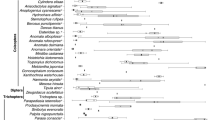Summary
The flight activity of Epiphyas postvittana was studied at two sites near Melbourne with the aid of suction traps, over a period of 4 years. Maximum numbers were found to fly during the period September to March with peak activity coinciding with the emergence of winter, spring and summer generation moths. E. postivittana is predominantly a nocturnal flier with maximum activity around 20.00–24.00 h. The lower temperature threshold of flight was 8–11°C. The upper temperature threshold varied from 20–21°C, 24–25°C and 27–28°C for the winter, spring and summer generation moths respectively. Flight was highly influenced by the prevailing wind. The lower wind speed threshold was 0.5–0.8 m-s and the upper wind speed threshold was 2.6–2.7 m-s. The relationship between wind speed and the amount of flight was non-linear, with the frequency of flights decreasing sharply with increasing wind speed. No flights occurred at wind speeds greater than 2.8 m-s. Variation in relative humidity had no influence on flight, but lack of rain favoured flight. The amount of flight activity and the amount of rainfall were negatively correlated; flights did not occur when the daily precipitation exceeded 32.5 mm, and with a precipitation exceeding 39 mm no flights could be expected. The value of these findings to pest control programmes is discussed.
Similar content being viewed by others
References
Bode, W.M., Asquith, D., Tette, J.P.: Sex attractants and traps for tufted apple budmoth and redbanded leafroller males. J. econ. Ent. 66, 1129–1130 (1973)
Chapman, P.J.: Bionomics of the apple-feeding tortricidae. A. Rev. Ent. 18, 73–96 (1973)
Danthanarayana, W.: The bionomics, distribution and host range of the light brown apple moth, Epiphyas postvittana (Walk.) (Tortricidae). Aust. J. Zool. 23, 419–437 (1975a)
Danthanarayana, W.: Factors determining variation in fecundity of the light brown apple moth, Epiphyas postvittana (Walker) (Tortricidae). Aust. J. Zool. 23, 439–451 (1975b)
Danthanarayana, W.: Diel and lunar flight periodicities in the light brown apple moth, Epiphyas postvittana (Walker) (Tortricidae) and their possible adaptive significance. Aust. J. Zool. 24, 65–73 (1976)
Johnson, C.G.: A suction trap for small airborne insects which automatically segregates the catch into successive hourly samples. Ann. appl. Biol. 37, 80–91 (1950)
Johnson, C.G., Taylor, L.R.: The development of large suction traps for airborne insects. Ann. appl. Biol. 43, 51–62 (1955)
Tachenberg, E.F., Cardé, R.T., Roelofs, W.L.: Sex pheromone mass trapping and mating desruption for control of redbanded leafroller and grape berry moth in vineyards. Environ. Ent. 3, 239–242 (1974)
Taylor, L.R.: The absolute efficiency of insect suction traps. Ann. appl. Biol. 50, 405–421 (1962)
Taylor, L.R.: Analysis of the effect of temperature on insects in flight. J. anim. Ecol. 32, 99–112 (1963)
Author information
Authors and Affiliations
Rights and permissions
About this article
Cite this article
Danthanarayana, W. Flight thresholds and seasonal variations in flight activity of the light-brown apple moth, Epiphyas postvittana (Walk.) (Tortricidae), in Victoria, Australia. Oecologia 23, 271–282 (1976). https://doi.org/10.1007/BF00345957
Received:
Issue Date:
DOI: https://doi.org/10.1007/BF00345957




